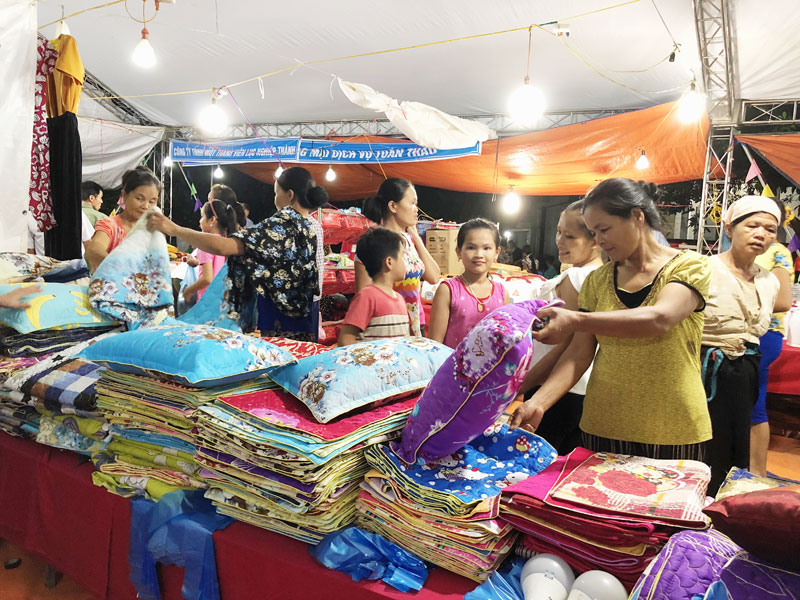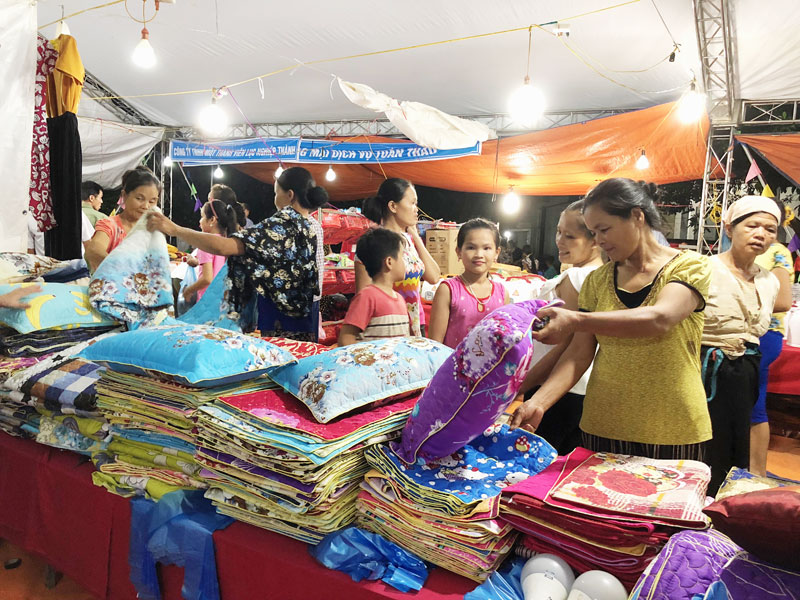
(HBO) - After 10 years of implementing the campaign "Vietnamese people prioritise using Vietnamese goods”, the northern province of Hoa Binh has brought locally-made products closer to people in rural and far-flung areas which have economic difficulties and unfavourable transport systems.
 A
market selling Vietnamese goods in the remote commune of Tu Ne, Tan Lac
district, draws a large crowd of locals and visitors.
A
market selling Vietnamese goods in the remote commune of Tu Ne, Tan Lac
district, draws a large crowd of locals and visitors.
More and more enterprises and manufacturers
inside and outside the province are participating in the programme and
supplying a diverse range of products suitable with the demands and preferences
of customers in rural and remote areas such as garments, household appliances,
aluminum and plastic products, porcelain ware, school supplies, electronic
products, telecom services, food, and agricultural production tools.
Manufacturers have also paid great attention to improving
the quality of products to satisfy consumers. Many businesses joining the
programme have reported steady growth in revenues through years, averagely
increasing by 1.5-2 times.
Chu Van Thang, Deputy Director of the provincial
Centre for Tourism, Trade and Investment Promotion Centre, said since 2009, Hoa
Binh has opened 34 markets selling Vietnamese goods in rural and remote areas
in Lac Son, Kim Boi, Tan Lac, Yen Thuy, Lac Thuy, Da Bac, Mai Chau and Cao
Phong districts. Of which, 18 were under the national trade promotion programme
in 2012, 2014, and 2018 with total expenses of nearly 2.4 billion VND (103,200
USD).
The programme will continue to be held in 2019
with the organisation of at least four markets in remote areas, he said, adding
that such events have been attracting more visitors, helping build trust of
customers in locally-made products.
The quality of the programme has been improved
through years, Thang said. Every year, the markets are held in different
regions to increase the spread of the campaign "Vietnamese people prioritise
using Vietnamese goods” among customers in rural and remote areas, he added.
Dao Village’s honey – a product certified with a 3-star OCOP (One Commune One Product) rating by Thong Nhat Agricultural Cooperative in Dao Village (Hoa Binh City) – is highly regarded by consumers for its quality, richness, and variety in packaging. The distinctively sweet taste of Dao Village’s honey leaves a lasting impression on anyone who has tried it.
In alignment with Project No. 07-DA/TU, issued by the Hoa Binh provincial Party Committee on November 1, 2021, Lac Thuy district has actively promoted investment and supported the sustainable development of its industrial and handicraft sectors during the 2021–2025 period. Alongside this, the district has remained committed to preserving and revitalising traditional craft villages.
Located in the northern part of Lac Thuy district, with a temperate climate and fertile soil, Phu Thanh commune has great potential and advantages in growing tea. The long-standing experience, combined with strict adherence to organic farming practices in the tea gardens, ensures that the dried tea products from Phu Thanh and Lac Thuy as a whole are sold out immediately upon production, providing a stable and prosperous life for the local people.
Amid efforts to streamline the administrative apparatus, Hoa Binh province has intensified measures to address challenges in land clearance, resettlement support, and infrastructure investment, aiming to speed up the progress of key projects.
Hoa Binh province has posted an unprecedented economic growth rate of 12.76% in the first quarter of 2025, marking its highest quarterly performance to date and positioning it as the second fastest-growing locality in the country, trailing only Bac Giang province.
Under current regulations, products in the One Commune – One Product (OCOP) programme that are rated three stars or higher must undergo re-evaluation every three months. However, in reality, some of these products fail to consistently meet the required standards, raising concerns about the sustainability of their OCOP certification. This underscores the urgent need for producers to enhance product quality and gradually develop their OCOP products into strong, marketable brands.



 A
market selling Vietnamese goods in the remote commune of Tu Ne, Tan Lac
district, draws a large crowd of locals and visitors.
A
market selling Vietnamese goods in the remote commune of Tu Ne, Tan Lac
district, draws a large crowd of locals and visitors.